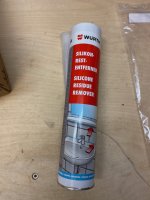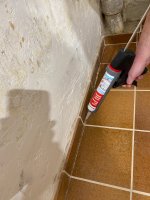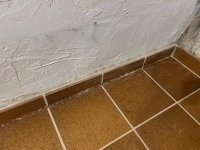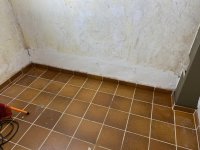six-point socket II
Member
- Joined
- Jun 26, 2016
- Messages
- 2,232
So I was dealing with some stubborn silicone residue lately and I got really tired of failed attempts to scrape or brush off ultra-thin silicone layers of my floor & trim tiles.
On my nightly research I stumbled over Würth's "Silicone Residue Remover" (0890500). Würth has been a great business partner ever since I started using them and even mid-pandemic they where able to deliver product on time that others couldn't.
The "issue" I had with the product in this case was price. Now I won't give any number, that would be against my contractual obligations, but let's just say my base price was about 5 times the cost of a typical, high-quality, caulk cartridge + VAT. So I e-mailed my agent and asked if she could do something about it, even though I'm just a fairly low profile client. Turns out she could, and the offer came back at now "just" 3 times the cost of a typical, high-quality, caulk cartridge + VAT.
Honestly, I felt playful and wanted to know what it's all about.
What was clear from the beginning, it's not a fluid/ liquid consistency like typical products, but a paste and will remain in place over the whole exposure time.
So here's the most expensive cartridge I've used to date.
[attachimg=1]
[attachimg=2]
To make use of another famous "The Wire" quote by Peter Gerety starring as "Judge Phelan": "Celebrities always seem much smaller when you meet them in person." [big grin]
Yours truly applying the good stuff.
[attachimg=3]
[attachimg=4]
Applied.
[attachimg=5]
The manual set out a minimum thickness of 5mm to be applied of the product, and an exposure time of 2 - 4 hours tops for the thickness of my residue. I went for the full 4 hours.
After 4 hours it had became a gooey/ gel like consistency and was easily scraped of and disposed in a small container. As you can see there is a lot of really fine strips of silicone residue embedded into the scraped off product.
[attachimg=6]
You're supposed to wash it off one more time after scraping, so I did.
[attachimg=7]
All the silicone residue was gone.
Now for the most pressing question, is it worth it?
- I did not find a comparable product. You can buy liquid solvents of all sorts to remove silicone, but most if not all of them require additional mechanical removal of the silicone residue. This product does not require you to do anything more but to simply scoop it up and dispose it after the exposure time is over and then to just wash off the remains with a sponge or cloth.
- I applied the product and was immediately able to continue working on other parts of the project. I did ensure proper ventilation.
- All the silicone residue was removed. It's spotless now and I can re-do the silicone.
- I spend way less time on my knees than I would have otherwise, because of my underlying health conditions this is a big factor for me.
So to finally answer that question, I think it is worth it. It is not cheap, but it's worth the money - at least to me. Now I will add that I don't think using it on the floor/trim like I did is actually really suitable for the product. You need 5mm of product minimum, and more when your silicone residue is thicker. Also exposure time gets longer the thicker your residue is. For what you see in my last picture I almost used the whole cartridge.
What I do think it is absolutely suitable/ perfect for is the use as pictured on the cartridge. When sinks or other (bathroom) vanities that were sealed with silicone need to be removed/replaced and you need a spotless surface afterwards for new installation. It will save you lots of time scraping and rubbing off silicone and silicone residue and leave you with a spotless surface.
Kind regards,
Oliver
On my nightly research I stumbled over Würth's "Silicone Residue Remover" (0890500). Würth has been a great business partner ever since I started using them and even mid-pandemic they where able to deliver product on time that others couldn't.
The "issue" I had with the product in this case was price. Now I won't give any number, that would be against my contractual obligations, but let's just say my base price was about 5 times the cost of a typical, high-quality, caulk cartridge + VAT. So I e-mailed my agent and asked if she could do something about it, even though I'm just a fairly low profile client. Turns out she could, and the offer came back at now "just" 3 times the cost of a typical, high-quality, caulk cartridge + VAT.
Honestly, I felt playful and wanted to know what it's all about.
What was clear from the beginning, it's not a fluid/ liquid consistency like typical products, but a paste and will remain in place over the whole exposure time.
So here's the most expensive cartridge I've used to date.
[attachimg=1]
[attachimg=2]
To make use of another famous "The Wire" quote by Peter Gerety starring as "Judge Phelan": "Celebrities always seem much smaller when you meet them in person." [big grin]
Yours truly applying the good stuff.
[attachimg=3]
[attachimg=4]
Applied.
[attachimg=5]
The manual set out a minimum thickness of 5mm to be applied of the product, and an exposure time of 2 - 4 hours tops for the thickness of my residue. I went for the full 4 hours.
After 4 hours it had became a gooey/ gel like consistency and was easily scraped of and disposed in a small container. As you can see there is a lot of really fine strips of silicone residue embedded into the scraped off product.
[attachimg=6]
You're supposed to wash it off one more time after scraping, so I did.
[attachimg=7]
All the silicone residue was gone.
Now for the most pressing question, is it worth it?
- I did not find a comparable product. You can buy liquid solvents of all sorts to remove silicone, but most if not all of them require additional mechanical removal of the silicone residue. This product does not require you to do anything more but to simply scoop it up and dispose it after the exposure time is over and then to just wash off the remains with a sponge or cloth.
- I applied the product and was immediately able to continue working on other parts of the project. I did ensure proper ventilation.
- All the silicone residue was removed. It's spotless now and I can re-do the silicone.
- I spend way less time on my knees than I would have otherwise, because of my underlying health conditions this is a big factor for me.
So to finally answer that question, I think it is worth it. It is not cheap, but it's worth the money - at least to me. Now I will add that I don't think using it on the floor/trim like I did is actually really suitable for the product. You need 5mm of product minimum, and more when your silicone residue is thicker. Also exposure time gets longer the thicker your residue is. For what you see in my last picture I almost used the whole cartridge.
What I do think it is absolutely suitable/ perfect for is the use as pictured on the cartridge. When sinks or other (bathroom) vanities that were sealed with silicone need to be removed/replaced and you need a spotless surface afterwards for new installation. It will save you lots of time scraping and rubbing off silicone and silicone residue and leave you with a spotless surface.
Kind regards,
Oliver








